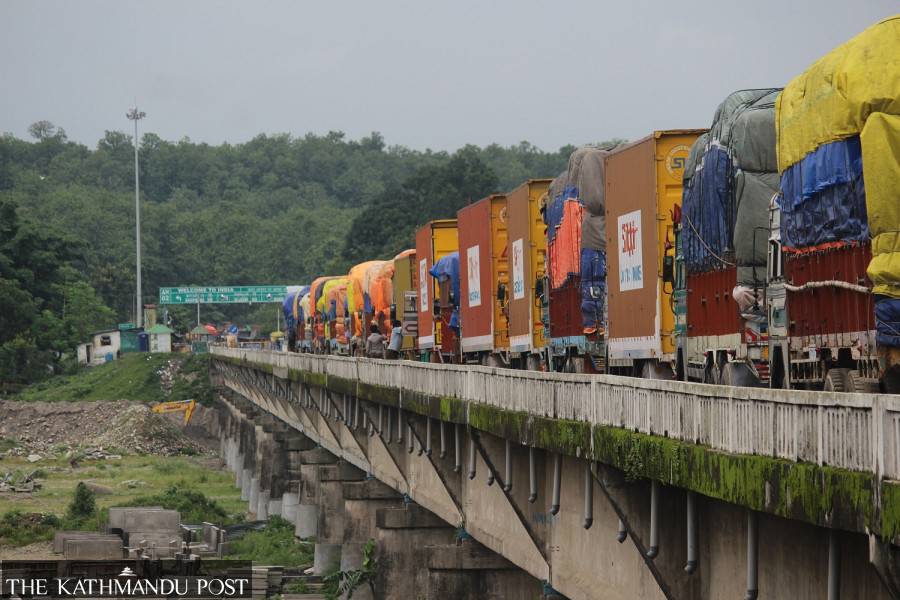Columns
Protecting trade with a competitive edge
It is important for Nepal to devote resources to finding alternative markets.
Paban Raj Pandey
Rice prices are surging in Nepal. Last July, India, the world’s largest rice exporter, banned the export of widely consumed non-Basmati white rice. There are similar restrictions—either a complete ban or allocation of export quotas through high duties on exports—on the export of wheat, sugar and onion. Ahead of the national elections being held over almost seven weeks from April 19, India was probably aiming at bringing down domestic prices by increasing supplies. Earlier this month, the southern neighbour lifted the ban on onion export—in effect since last December—but with a minimum export price of $550 per tonne, which traders fear could exert upward pressure on prices in Nepal.
As a nation increasingly reliant on Indian imports to fill domestic gaps in, let us say, onion supply, Nepal may just be an unintended victim, but this also lays bare the unbalanced nature of its trade balance. India is Nepal’s largest trade partner. In the last fiscal year through mid-July 2023, Nepal ran a trade deficit of Rs1,455 billion, of which Rs921 billion—or over 63 percent of the total—was attributed to India. The next largest deficit, Rs221 billion, or just over 15 percent, was with China. India also made up just over 64 percent of Nepal’s merchandise trade at Rs1,769 billion, with China a distant second at under 13 percent. Simply put, the Nepal-India trade relationship is dangerously lopsided.
The cultural, religious, societal and other ties between India and Nepal go back to history. Topographically, the southern border is plain and, therefore, porous. In contrast, Nepal’s border to the north with China’s Tibet is harsh, mountainous and has inadequate road connections. For a landlocked nation, over time, Nepal’s trade reliance on India became the path of least resistance. This should hardly come as a surprise. What is surprising is the prevailing deteriorating trend. Until not too long ago, Nepal used to be self-sufficient in staples like rice. However, it is no longer so. Importantly, nearly all its petroleum needs are fulfilled by India. This kind of dependence can give any nation the temptation to take undue advantage.
Protectionism: Pros and cons
Last month, 17 truckloads of India-bound Nepali tea were stopped by Indian customs for five days on the eastern border, citing a Commerce Ministry circular to mandatorily conduct lab tests on all tea imports from Nepal; previously, tests were done on five to 20 percent of Nepali tea. Ilam’s tea is a competitor to Darjeeling’s. Nepali traders also complain of India’s anti-dumping duties—which are levied on imported goods believed to be priced below fair market value—as one of the primary reasons for a decline over the years in Nepali readymade jute products. Repeated requests, including by Prime Minister Pushpa Kamal Dahal during his India visit last year, to lift the duties have fallen on deaf ears.
Anti-dumping duties are protectionist by nature. The importing countries believe they are facing unfair competition from imports, so they are trying to protect their own jobs and industries. The World Trade Organization does allow anti-dumping measures if it is determined that dumping is occurring. But these duties can be equally abused as a means of protecting inefficient industries and thereby stifling market competition. The importing countries routinely try to find ways to inflate the duties imposed. In jute’s case, it is ironic that Indian consumers will end up paying more. In Nepal’s eyes, India is being protectionist. India will probably argue it is levelling the playing field.
Protectionism comes in many shades—primarily tariffs, quotas and subsidies. They are all aimed at defending domestic companies by making foreign goods more expensive or scarce. It is practised globally. Nowhere is this more visible currently than in the electric vehicle (EV) industry. China has ascended quickly to become the largest producer and exporter of these vehicles. There are nearly 100 EV companies there. The Chinese government’s subsidies—direct (cash incentives) or indirect (interest-free loans, tax breaks, among others)—to solar panels, EVs and lithium-ion batteries are well-known. Overcapacity at home forces these manufacturers to look for opportunities abroad, stoking trade tensions.
The right industrial policy
For consumers, this means lower prices. In the March quarter, China’s BYD—known for its affordable four-wheelers—surpassed Tesla to become the top seller of EVs globally. But for the US and European auto manufacturers, with decades of history and leadership, it translates to fear that they will be priced out. In the past, Europe used to lead in solar panel production; the industry was decimated by Chinese competition. Autos are a sensitive issue politically in both Europe and the United States. Both Brussels and Washington have repeatedly raised the issue of overcapacity in China and how this likely overwhelms factories in their countries. As an antidote, tariffs on Chinese EVs increasingly look likely.
A few Chinese EV companies are already building factories in Mexico, which is a member of the North American Free Trade Agreement. This comes at a time when the US itself is incentivising domestic production of EVs, EV batteries, chips, etc., which it views as strategic. China, in fact, recently filed a complaint with the WTO contesting discriminatory subsidy policies for EVs under the Joe Biden administration’s Inflation Reduction Act—one of three major investment bills passed since November 2021 with billions of dollars in loans, grants and tax credits targeted at reviving the country’s productivity, innovation and manufacturing base. Risks of tariffs are forcing companies to start producing in the US.
Tariffs run the risk of provoking counter-tariffs. For a tiny country like ours, which is trade-dependent on its big neighbours, these dynamics are different. Using the case of jute as an example, there is nothing Nepal can do about it except take it lying down. Nepal imports most of the raw jute used to make jute products from India and Bangladesh, so there is no competitive advantage. It is a cliché, but it is also worth repeating. The policymakers should strive for an industrial policy that promotes products with a competitive edge and stick to it no matter who occupies Singha Durbar. It is equally important for Nepal to devote resources to finding alternative markets.




 20.12°C Kathmandu
20.12°C Kathmandu















